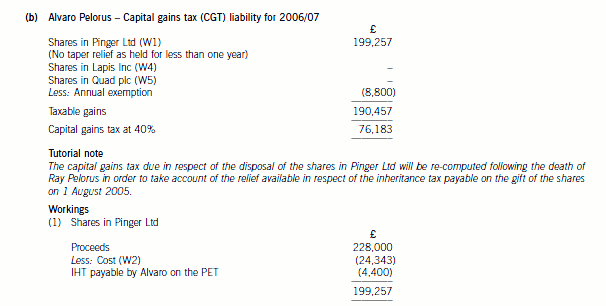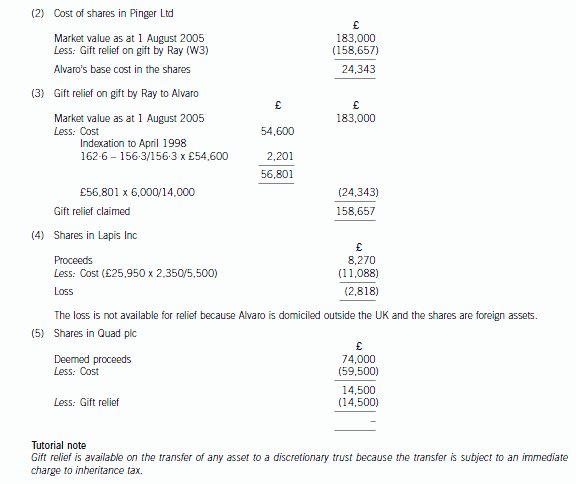ACCAF1考试-会计师与企业(基础阶段)模拟试题(2020-10-11)
发布时间:2020-10-11
各位参加2020年ACCA考试的小伙伴们注意啦!今天51题库考试学习网给各位小伙伴分享ACCAF1考试-会计师与企业(基础阶段)模拟试题练习18,感兴趣的小伙伴赶快来围观哦!
18.1 Which of the following would be an
effective technique for encouraging healthy team solidarity?
A Discouraging competition with other
groups.
B Encouraging competition within the group.
C Encouraging members to express
disagreements.
D Discouraging members from expressing
disagreements.
答案:C
18.2 What is the most important attribute
of a \'group\', which distinguishes it from a random crowd of people?
A Purpose
B Conformity
C Identity
答案:C
18.3 In Belbin\'s model of team roles, which
of the following is most important for a well-functioning team?
A A mix and balance of team roles.
B Nine members, so that all roles are
filled.
C A focus on functional/task roles, not
process roles.
D As few members as possible.
答案:A
18.4 Which of the following is not a key
tool of team building?
A Members identify with the team.
B Members are as alike as possible.
C Members commit to shared objectives.
答案:B
18.5 Grant is a member of a project team.
His colleagues in the team rely on him to read and check complex project
documentation. Grant has a keen eye for detail and often identifies minor
details in documents that others miss but may be of significance. Despite the
diligent approach, Grant always meets his deadlines. However, some of Grant\'s
colleagues feel frustrated when he refuses to involve others. He can hold up
progress as he will not agree to the team signing off project documents until
all of his concerns are fully discussed. According to Belbin\'s team roles
theory, Grant is an example of which of the following?
A Implementer
B Completer – finisher
C Monitor – evaluator
D Shaper
答案:B
18.6 Which of the following is not a key
tool of team building?
A Members identify with the team.
B Members are as alike as possible.
C Members commit to shared objectives.
答案:B
今天的试题分享到此结束,预祝各位小伙伴顺利通过接下来的ACCA考试,如需查看更多ACCA考试试题,记得关注51题库考试学习网!
下面小编为大家准备了 ACCA考试 的相关考题,供大家学习参考。
(b) Using the information provided, state the financial statement risks arising and justify an appropriate audit
approach for Indigo Co for the year ending 31 December 2005. (14 marks)
(b) Financial statement risks
Assets
■ There is a very high risk that inventory could be materially overstated in the balance sheet (thereby overstating profit)
because:
? there is a high volume of metals (hence material);
? valuable metals are made more portable;
? subsidy gives an incentive to overstate purchases (and hence inventory);
? inventory may not exist due to lack of physical controls (e.g. aluminium can blow away);
? scrap metal in the stockyard may have zero net realisable value (e.g. iron is rusty and slow-moving);
? quantities per counts not attended by an auditor have increased by a third.
■ Inventory could be otherwise misstated (over or under) due to:
? the weighbridge being inaccurate;
? metal qualities being estimated;
? different metals being mixed up; and
? the lack of an independent expert to identify/measure/value metals.
■ Tangible non-current assets are understated as the parts of the furnaces that require replacement (the linings) are not
capitalised (and depreciated) as separate items but treated as repairs/maintenance/renewals and expensed.
■ Cash may be understated due to incomplete recording of sales.
■ Recorded cash will be overstated if it does not exist (e.g. if it has been stolen).
■ Trade receivables may be understated if cash receipts from credit customers have been misappropriated.
Liabilities
■ The provision for the replacement of the furnace linings is overstated by the amount provided in the current and previous
year (i.e. in its entirety).
Tutorial note: Last replacement was two years ago.
Income statement
■ Revenue will be understated in respect of unrecorded cash sales of salvaged metals and ‘clinker’.
■ Scrap metal purchases (for cash) are at risk of overstatement:
? to inflate the 15% subsidy;
? to conceal misappropriated cash.
■ The income subsidy will be overstated if quantities purchased are overstated and/or overvalued (on the quarterly returns)
to obtain the amount of the subsidy.
■ Cash receipts/payments that were recorded only in the cash book in November are at risk of being unrecorded (in the
absence of cash book postings for November), especially if they are of a ‘one-off’ nature.
Tutorial note: Cash purchases of scrap and sales of salvaged metal should be recorded elsewhere (i.e. in the manual
inventory records). However, a one-off expense (of a capital or revenue nature) could be omitted in the absence of
another record.
■ Expenditure is overstated in respect of the 25% provision for replacing the furnace linings. However, as depreciation
will be similarly understated (as the furnace linings have not been capitalised) there is no risk of material misstatement
to the income statement overall.
Disclosure risk
■ A going concern (‘failure’) risk may arise through the loss of:
? sales revenue (e.g. through misappropriation of salvaged metals and/or cash);
? the subsidy (e.g. if returns are prepared fraudulently);
? cash (e.g. if material amounts stolen).
Any significant doubts about going concern must be suitably disclosed in the notes to the financial statements.
Disclosure risk arises if the requirements of IAS 1 ‘Presentation of Financial Statements’ are not met.
■ Disclosure risk arises if contingent liabilities in connection with the dumping of ‘clinker’ (e.g. for fines and penalties) are
not adequately disclosed in accordance with IAS 37 ‘Provisions, Contingent Liabilities and Contingent Assets’.
Appropriate audit approach
Tutorial note: In explaining why AN audit approach is appropriate for Indigo it can be relevant to comment on the
unsuitability of other approaches.
■ A risk-based approach is suitable because:
? inherent risk is high at the entity and financial assertion levels;
? material errors are likely to arise in inventory where a high degree of subjectivity will be involved (regarding quality
of metals, quantities, net realisable value, etc);
? it directs the audit effort to inventory, purchases, income (sales and subsidy) and other risk areas (e.g. contingent
liabilities).
■ A systems-based/compliance approach is not suited to the risk areas identified because controls are lacking/ineffective
(e.g. over inventory and cash). Also, as the audit appointment was not more than three months ago and no interim
audit has been conducted (and the balance sheet date is only three weeks away) testing controls is likely to be less
efficient than a substantive approach.
■ A detailed substantive/balance sheet approach would be suitable to direct audit effort to the appropriate valuation of
assets (and liabilities) existing at balance sheet date. Principal audit work would include:
? attendance at a full physical inventory count at 31 December 2005;
? verifying cash at bank (through bank confirmation and reconciliation) and in hand (through physical count);
? confirming the accuracy of the quarterly returns to the local authority.
■ A cyclical approach/directional testing is unlikely to be suitable as cycles are incomplete. For example the purchases
cycle for metals is ‘purchase/cash’ rather than ‘purchase/payable/cash’ and there is no independent third party evidence
to compensate for that which would be available if there were trade payables (i.e. suppliers’ statements). Also the cycles
are inextricably inter-related to cash and inventory – amounts of which are subject to high inherent risk.
■ Analytical procedures may be of limited use for substantive purposes. Factors restricting the use of substantive analytical
procedures include:
? fluctuating margins (e.g. as many factors will influence the price at which scrap is purchased and subsequently
sold, when salvaged, sometime later);
? a lack of reliable/historic information on which to make comparisons.
(b) Calculate Alvaro Pelorus’s capital gains tax liability for the tax year 2006/07 on the assumption that all
available reliefs are claimed. (8 marks)


(b) Calculate the amount of input tax that will be recovered by Vostok Ltd in respect of the new premises in the
year ending 31 March 2009 and explain, using illustrative calculations, how any additional recoverable input
tax will be calculated in future years. (5 marks)
(b) Recoverable input tax in respect of new premises
Vostok Ltd will recover £47,880 (£446,500 x 7/47 x 72%) in the year ending 31 March 2009.
The capital goods scheme will apply to the purchase of the building because it is to cost more than £250,000. Under the
scheme, the total amount of input tax recovered reflects the use of the building over the period of ownership, up to a maximum
of ten years, rather than merely the year of purchase.
Further input tax will be recovered in future years as the percentage of exempt supplies falls. (If the percentage of exempt
supplies were to rise, Vostok Ltd would have to repay input tax to HMRC.)
The additional recoverable input tax will be computed by reference to the percentage of taxable supplies in each year including
the year of sale. For example, if the percentage of taxable supplies in a particular subsequent year were to be 80%, the
additional recoverable input tax would be computed as follows.
£446,500 x 7/47 x 1/10 x (80% – 72%) = £532.
Further input tax will be recovered in the year of sale as if Vostok Ltd’s supplies in the remaining years of the ten-year period
are fully vatable. For example, if the building is sold in year seven, the additional recoverable amount for the remaining three
years will be calculated as follows.
£446,500 x 7/47 x 1/10 x (100% – 72%) x 3 = £5,586.
(ii) The UK value added tax (VAT) implications for Razor Ltd of selling tools to and purchasing tools from
Cutlass Inc; (2 marks)
(ii) Value added tax (VAT)
Goods exported are zero-rated. Razor Ltd must retain appropriate documentary evidence that the export has taken place.
Razor Ltd must account for VAT on the value of the goods purchased from Cutlass Inc at the time the goods are brought
into the UK. The VAT payable should be included as deductible input tax on the company’s VAT return.
声明:本文内容由互联网用户自发贡献自行上传,本网站不拥有所有权,未作人工编辑处理,也不承担相关法律责任。如果您发现有涉嫌版权的内容,欢迎发送邮件至:contact@51tk.com 进行举报,并提供相关证据,工作人员会在5个工作日内联系你,一经查实,本站将立刻删除涉嫌侵权内容。
- 2020-10-08
- 2020-10-11
- 2020-08-13
- 2020-08-13
- 2020-08-13
- 2020-08-13
- 2020-10-11
- 2019-01-05
- 2019-03-21
- 2020-08-13
- 2020-08-13
- 2020-10-08
- 2020-10-11
- 2020-08-13
- 2020-08-13
- 2020-08-13
- 2020-08-13
- 2020-08-13
- 2020-08-13
- 2020-10-11
- 2020-10-11
- 2020-08-13
- 2020-08-13
- 2020-10-11
- 2020-10-11
- 2020-08-13
- 2020-10-08
- 2020-08-13
- 2019-01-05
- 2020-08-13